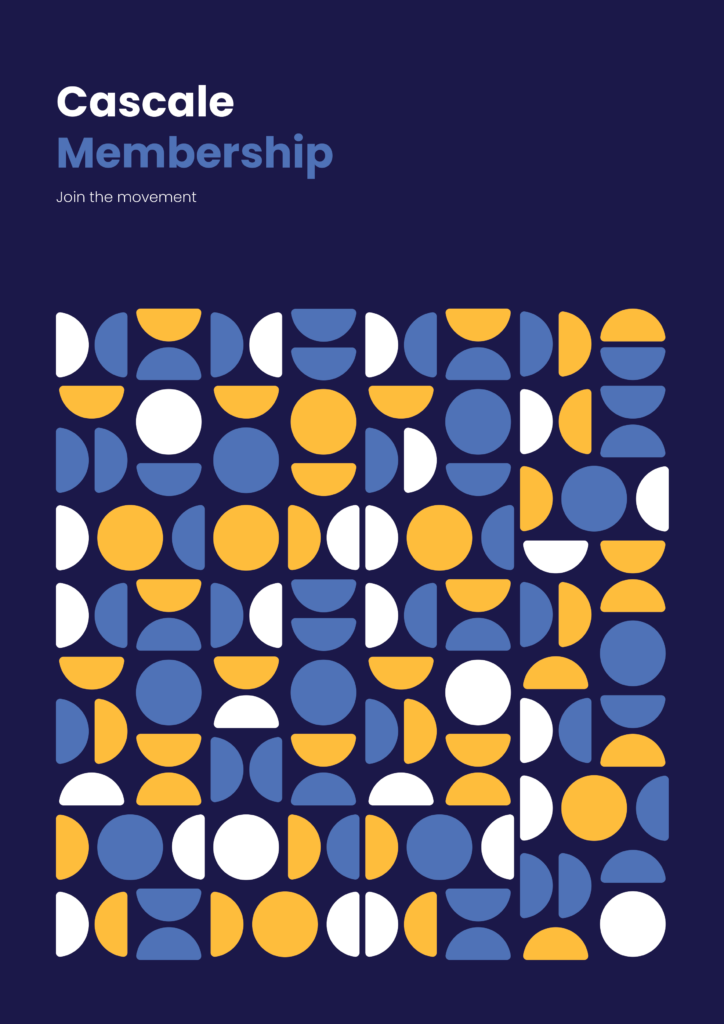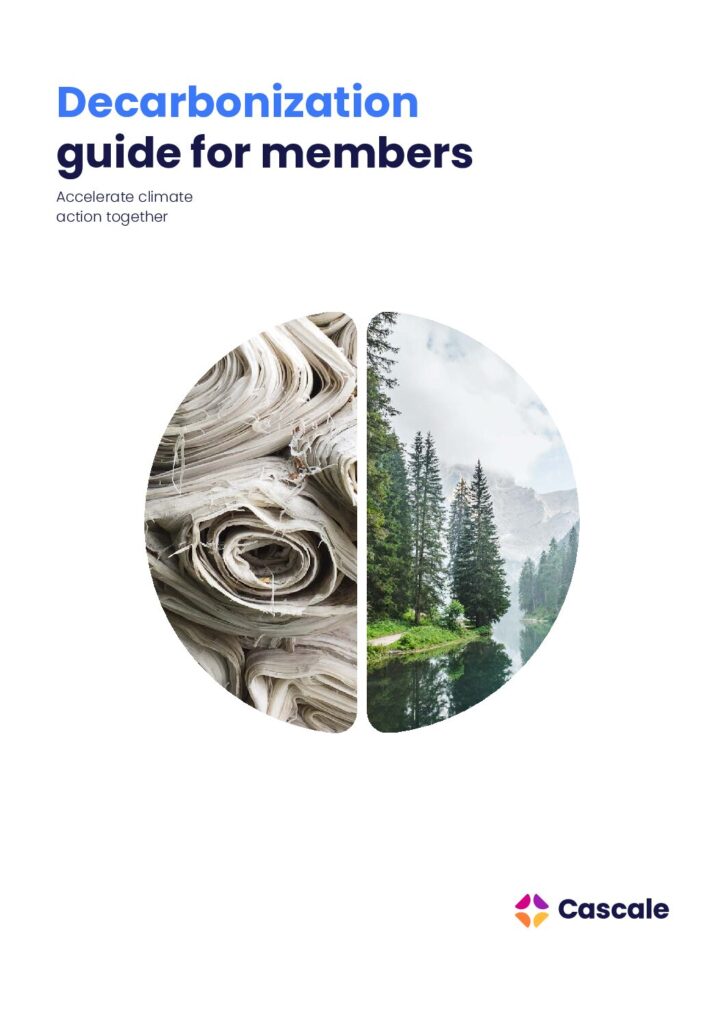
Dear Fashion: Let’s Step Up and Get Aligned
In a recent opinion editorial with WWD, CEO Colin Browne argues fashion needs to take more serious and coordinated action on sustainability. Read the highlights here!
Discover the possibilities of becoming a member of Cascale, formerly Sustainable Apparel Coalition (SAC), by downloading our membership brochure. Take the first step towards unlocking valuable benefits, industry insights, and a supportive global community.

This training course equipped sustainability professionals with the necessary knowledge and skills required to set near-term SBTs for the Scope 1 and 2 GHG emissions.
Our reflections on driving positive progress, addressing challenges and fostering collective impact within the textile and apparel industry.



So many of us appreciate how much the natural world means to our mental and physical health. But as nature nears a tipping point, there’s now so much more at stake.
Nature loss now threatens people and the planet. To put this in perspective, our world’s wildlife populations plummeted by 69% between 1970 and 2022 due to our unsustainable use of our planet’s resources.
That’s not just a tragedy for all the incredible life-forms that run, fly, swim, grow and inhabit the world alongside us, enriching us in countless ways. It’s an alarming sign of how quickly we’re moving towards the collapse of complex, interwoven ecosystems on which all of life on earth depends – including us.
We need fertile soils, thriving oceans, plentiful forests, balanced and diverse species and clean water systems to survive. Scientists and experts warn that we need every one of these aspects of nature to help us reduce the intensity and frequency of climate-related risks.
30 x 30 is a wake-up call to use the tools and knowledge we have and unleash the creativity and innovation needed to restore nature before it’s too late.
The 30 x 30 goal is to put aside 30% of the world for nature by 2030. It was agreed at the United Nations Biodiversity Conference (COP15), and is an ambitious but vital target.
30 x 30 gives us aligned goals that we collectively need to hold ourselves accountable to, and to achieve, in order to bring nature back from the brink.
So what does that mean for our industry?
The textile and apparel industry has huge impacts on nature, due to our use of water and chemicals, and our greenhouse gas emissions. These are all key drivers of biodiversity loss.
But the way I see it, this heavy impact also offers us great opportunities in terms of reversing the trend, co-creating solutions together and positively contributing to the global communities in which we operate.
Here’s one example that proves we not only urgently need to do this, but that we absolutely can.
At the Sustainable Apparel Coalition (SAC), we continue to see companies putting competition aside to collaborate to achieve a 45% reduction in emissions by 2030.
Our Decarbonization Program is the result of work we are doing with our members and industry partners, as are many other industries, to ensure meaningful action and impact. It will take nothing less than working hand in hand across the value chain to increase education, sharing of best practices and ensuring real progress towards shared goals. While there is more to do, we’ve learned a lot from it. So let’s build on these learnings to advance progress more rapidly when it comes to nature restoration.
What’s the first thing we know we need to do? Get our framework right.
We need to use science-based targets for nature to form action plans that everyone in our sector is working towards. By aligning on achieving science-based, measurable targets and benchmarks, SAC members can make real and vital progress.
Our industry has an ability to bring people and knowledge together to collaborate and co-create solutions; catalyzing collective action to protect people and planet.
The era of working in silos is over. The future lies in harnessing the textile and apparel industry’s vast amount of talent, creativity, innovation and ingenuity, and collaborating to protect nature.
Let’s also make the most of the tools and systems we’ve created to take action against reversing biodiversity loss.
At SAC we’re already incorporating biodiversity within our Higg Index suite of tools that allow brands and retailers to assess their impacts.
For example, we recently made biodiversity a category in a major update to our Higg Brand and Retail Module (BRM), one of the five assessment tools within the Higg Index, allowing brands and retailers to assess their impacts when it comes to land use and habitat protection, including more in-depth questions on water and circularity as key levers of change.
We developed the update in collaboration with members and key partner organizations to ensure close alignment with standard assessment protocols.
We’re also exploring opportunities to utilize our Higg Facility Environmental Model (FEM) to help achieve nature-based targets – including using the vast amount of data we have gathered on chemical usage, water usage and wastewater, to identify hotspots where businesses can drive collective action for substantial impact.
Our data, insights and scale of our membership offer significant opportunities for helping to address fashion’s biodiversity cost.
Reversing the alarming rate of nature loss, and creating a thriving, resilient and just future, requires urgently transforming our systems. Based on more than a decade of collaboration, we know that if you put in place the tools, processes and policies, they do work. There are countless examples of specific actions that can yield outsized positive impacts, but more needs to be done to significantly scale these types of interventions to halt and reverse biodiversity loss.
From boardrooms and sourcing teams to manufacturing floors and policy makers, now’s the time for radical collaboration to restore nature. Together, we can make the changes needed to bring nature back from the edge.
The Decarbonization Guide for Members supports the fashion and apparel sector in committing to science-based targets and delivering against validated SBTs.



Since our inception in 2009, the Sustainable Apparel Coalition (SAC) has always recognized that sustainability is a multifaceted topic. From an environmental perspective, to social and labor issues at a global scale, there are a multitude of aspects to take into consideration, including: impacts in creating different synthetic and natural raw materials, the manufacturing decisions to convert those raw materials into products, the number of times a product is used to what happens to it at the end of its life, as well as responsible purchasing practices and the conditions in which garment makers work.
Given this complex reality, measuring sustainability can never be narrowed down to one single criterion. We have always advocated that our members, including retailers, brands, manufacturers and affiliates, adopt a broad approach – ensuring production methods, social impacts, and the entire value chain are considered. That’s why our Higg Index suite of tools for measuring sustainability cover topics as varied as water use, carbon emissions, and labor conditions.
In conjunction with industry specialists, our world class team of experts have created this array of tools to measure impacts at every point in a piece of apparel’s life cycle – reflecting real world complexity. Working with experts, our tools continue to evolve with scientific and data developments, alongside of course the needs of our members. They have been developed based on intervention points that we know make a difference to impact, including those that aren’t always directly quantifiable. Here are just some of the subjects they tackle:
Emissions
Reducing greenhouse gas emissions is vital. To achieve net zero and stop global warming from spiraling out-of-control, it’s essential that all manufacturers, retailers, brands, and suppliers urgently decarbonize. The first step in doing so is to measure current emissions. To help our members do this properly, our tools offer a comprehensive approach.
Take our Higg Material Sustainability Index (MSI) as a case in point, which has recently been updated to include more than 20 new materials and processes, making it one of the largest updates that the tool has experienced. Using primary data submitted by our members and other industry players, it assesses the complete cradle-to-grave impacts of different materials, including emissions.
The process data in the Higg MSI uses an LCA approach that factors in all the way to Scope 3 emissions. This includes indirect emissions that may be otherwise hidden from a user, like the energy required to mine resources, and all the manufacturing emissions related to the upstream value chain inputs. To drive collective and urgent action on emissions reduction, we recently launched our Decarbonization Program. It requires all our members to set Science-Based Targets, which provide a clearly defined path to reduce emissions in line with Paris Agreement goals, and we are educating members and sharing best practices on how to set targets and implement them.
Supply Chains
Fashion is a complex global industry, with supply chains criss crossing continents. In this context, true sustainability can only be achieved through collective action. No brand or retailer can do this alone. Each is reliant on multiple suppliers and must bring them on its sustainability journey.
Accordingly, we advise all our members to map out and understand their supply chains, and work with them to develop roadmaps to set targets and drive improvements. This includes decarbonization, reducing water consumption, cutting waste, and ensuring fair pay and conditions for all workers.
To this end, our Higg Facility Environmental Module (FEM) offers insights for manufacturers, brands, and retailers on the environmental performance of individual factories or production facilities. For example, it measures the carbon intensity of their manufacturing processes based on the energy grid mix – in terms of renewables versus fossil fuels – of their geographic location, when that information is available and can be independently validated.
In practice, this means it can show the difference in manufacturing emissions in countries like Indonesia or China, where the energy grids tend to be more fossil-fuel-based, versus somewhere like Europe, where renewables are more common.
From a social perspective, our Higg Facility Social & Labor Module (Higg FSLM) helps to promote safe and fair social and labor conditions for value chain workers all over the world. It offers not only a scoring model eliminating the need for brands to conduct individual audits to assess facilities’ performance, and reduce audit fatigue, but allows businesses to dedicate time and resources to making lasting systemic changes, instead of focusing on compliance.
Product Processing Choices
Fashion brands must also consider how products are made. Different methods result in different emissions and environmental impacts. To keep their carbon footprint to a minimum, companies can compare the scale of emissions generated by different processes using our Higg MSI. To make this comparison possible, we use an industry average in terms of the carbon intensity of the energy grid mix. Once they’ve compared the relative impacts of similar processes, they can then use our Higg FEM to select which factory, in which part of the world, offers the right process in combination with a low-carbon local energy grid mix.
Different Fabrics
Raw materials are significant, although sometimes their importance can be overestimated. The reality is that they are just one part of the picture. Using impact data from the Higg MSI, the World Resources Institute and Apparel Impact Institute released a report which revealed that raw materials only account for roughly a quarter of the impact of manufacturing a product – even before including use or end of life.
The nature of a fabric – whether or not it is natural, synthetic, organic, or recycled – is not the predominant issue in how sustainable it is, as the interventions highlighted from that report show.
Indeed, data from our Higg MSI shows that simply switching fibers often doesn’t result in any meaningful reduction in a garment’s carbon footprint. Other factors – like the emissions embedded in its production – tend to be more influential. These choices also tend to have less effect on the functionality of a product. A design brief often specifies the type of material that should be used, since this changes the function of a product. Polyester t-shirts and cotton t-shirts are different. But the decision to dye a fabric in a conventional way or to use a lower impact method isn’t something that’s typically specified in a product brief and is something that can be influenced directly.
Wears Per Garment
Poorly designed clothing is clearly less sustainable than high quality garments that are loved and used for years on end. We believe it’s crucial that the quality and longevity of a brand’s products are assessed as part of their sustainability ranking. Our Higg Product Module (PM) measures the cradle-to-grave environmental impacts of a product from the point of resource extraction to manufacturing impacts, all the way through product durability, care, and end of use. The default reporting metric of the Higg PM considers both the total footprint of the product and how long it will be used for (wears per garment), and we’ve continued to advocate and support this ‘impact per wear’ approach as part of our role in developing the PEFCR Technical Secretariat.
True Sustainability
An umbrella term covering a series of interlinked issues, sustainability is multifaceted. Sometimes, addressing one requires trade offs elsewhere. The key is to analyze the most scientifically accurate data in every area and then create a comprehensive plan. There are seldom simple fixes.
But we must not let the scale of the challenge daunt us. The fashion world is packed full of extraordinary talent. We have the tools, skills, creativity, and capability to embark on this collective journey of self-improvement. When it comes to protecting both people and the planet, we should always aspire to be better. In practice, this means taking a broad approach.